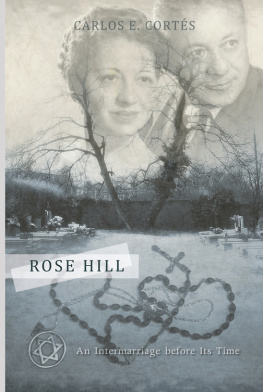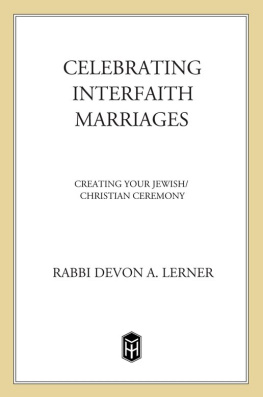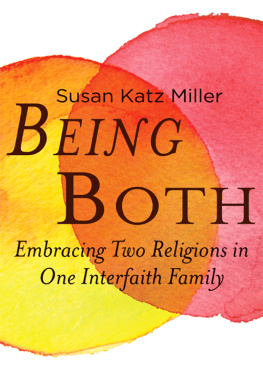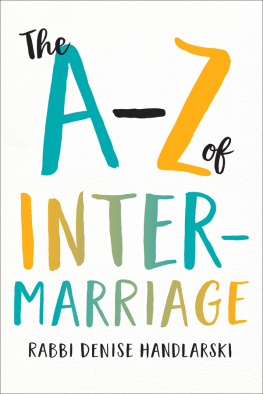M arriage between Christians and Jews has skyrocketed in the last two decades. As barriers of prejudice and tradition tumble, the percentage of Jews marrying out has shot from 6 percent thirty years ago to a current level of somewhere between 24 and 40 percent.
Intermarriage is easier today because religion has become less a determinant of peoples lives: In the last generation, America has become largely a secular culture. Frequently, both partners in an intermarriage have lived in similar neighborhoods, had similar educations, and feel there is no essential cultural or philosophical difference between them.
But as they stride along confidently, a mixed couple may suddenly stumble into unanticipated pitfalls. The truth is that the differences have not vanished and the pull of tradition has not died. Sometimes, despite their apparently smooth blend, a couple finds that cultural differences create tensions or misunderstandings. As people get older, latent loyalties can surface. Often, there is community and family opposition.
The community opposition is more likely to come from the Jewish side. Intermarriage takes place in a curious force field, with alarm on the Jewish end and near-silence from Christianity. Jewish tradition has emphasized the importance of maintaining the Jewish people, religion, and way of life distinct from all the surrounding cultures, and has long frowned upon and even forbidden marrying out. Jews have always been a small minority, and the modern Jewish population suffered heavy losses from the Nazi Holocaust in Europe and from assimilation in America. Intermarriage is seen by many Jews as another equally serious threat to the survival of Judaism. As the proportion of Jews intermarrying has surged upward, Jewish leaders have expressed anguish, studies have been launched, and programs are being aimed at this target population. To Christianity, however, intermarriage with Jews is only a tiny minority of Christian marriages. Because of that demographic difference, and because of Christianitys newfound respect for Judaism, Christian institutions have been largely silent and inactive on this front.
We decided to step into this force field because we saw the need for an independent, nondenominational handbook to help couples make their way through the emotional and practical issues that arise. Both of us have had personal experience with intermarriage. Jim Remsen, a lapsed Methodist, is married to a Jewish woman and assists in the Jewish upbringing of their children. Judy Petsonk, an actively involved Conservative Jew, is not intermarried but has dealt with a number of intermarriages in her family.
Weve traveled across the country to talk with one hundred fifty intermarried people, as well as forty-three children of intermarriage ranging in age from five to forty-eight. We also interviewed one hundred seventy-three counselors, therapists, clergy, and professionals who work with intermarried couples.
We tried to talk to intermarried people who had a wide variety of experiences and had made widely differing choices, and to look for common patterns. Nationwide, many more intermarried families choose a Jewish orientation than a Christian one, and our range of families reflects that.
We use the term intermarriage broadly, to include mixed couples as well as ones where one partner has converted to the others religion. Though conversion officially confers a one-religion home, the spouses will always have different backgrounds, families, and cultural traits.
The book is organized according to the life cycle of the family. It is designed to be useful both to couples who are engaged or newly married, and to families who are in midstream and suddenly find religion arising as an issue. We think much of the information can also be helpful to nontraditional families, such as gay or lesbian couples, or others who live together.
You will find five types of information:
1) Practical information This includes, for example, the major movements positions on intermarriage, as well as where to find clergy who will conduct weddings for intermarried couples.
2) Psychological information This will help you understand whats going on under the surface when a problem arises. For example, we look at the family power struggles that can erupt around an engagement or wedding.
3) Written and verbal exercises These will help you draw out your feelings about the issues you face. We suggest you join or organize an interfaith couples discussion group and do the exercises and talk about the chapters there. Or, do the exercises with your spouse or partner. Keep written exercises in a looseleaf notebook so that you have a record of your journey through the issues and decisions of intermarriage.
4) Case studies These are stories of real families and how they dealt with the issue under discussion. Except where stated otherwise, the names of the people and most identifying details have been changed. Some of the families had painful tales of major conflicts. But most felt they were getting on fine. Their initial reaction was, Why talk to us? We dont have any problems. Yet when the stories began to unfold, we found there was not a single family whose lives had not been affected in important ways by their intermarrying. Intermarriage had enriched many of them, but it had made life more complicated for all. We hope that their insights and experiences will shed light on your situation and help you move toward a constructive solution.
5) Practical tips and recommendations We have tried to present a range of options available on the major issues that arise, such as what to do about the wedding, holidays, rites of passage, and religious education. Our goal is to help you avoid getting stuck, to avoid thinking that you must choose between two unacceptable or mutually exclusive paths. Instead, we hope you will see a variety of possibilities and be able to stretch toward a mutually agreeable solution without feeling either of you has forsaken his or her own integrity. At the same time, we have tried to present our observations and best judgment about the strengths and weaknesses of particular approaches.
All marriages require compromise, but intermarriage raises the stakes. At most interfaith weddings, there are two invisible attendants: ambivalence and loss. The ambivalence comes from the pull and counter-pull of the various loyalties and resentments you feel toward your own and your spouses families and cultures. That ambivalence can cause you to be paralyzedto avoid decisions about your familys lifestyleor to be inconsistent, to make contradictory or changing decisions. The antidotes are self-awareness and communication. We hope the book helps you achieve these goals.
The second issue is loss. In any compromise in an intermarriage, someone, perhaps many people, will feel they are losing something precious. This book will help you to discern where any losses are occurringto acknowledge them, and to deal with them. Often we saw one or both partners shoving ahead to a decision without taking account of the sadness and other sensitive feelings at work beneath the surface. The healthier approach is to weigh everyones needs openly, acknowledge the trade-offs that are made, and push on, while staying sensitive to shifts in emotions and being prepared to adjust the arrangement if necessary. You cannot make the feeling of loss go away, but you can keep it from corroding relationships.
Remember that you are pioneers. This is the first generation in which marriage between Christians and Jews has taken place on a massive scale. As you explore what it means for people from two religions to live together in love and respect, keep in mind that you are pushing forward on a new frontier.









